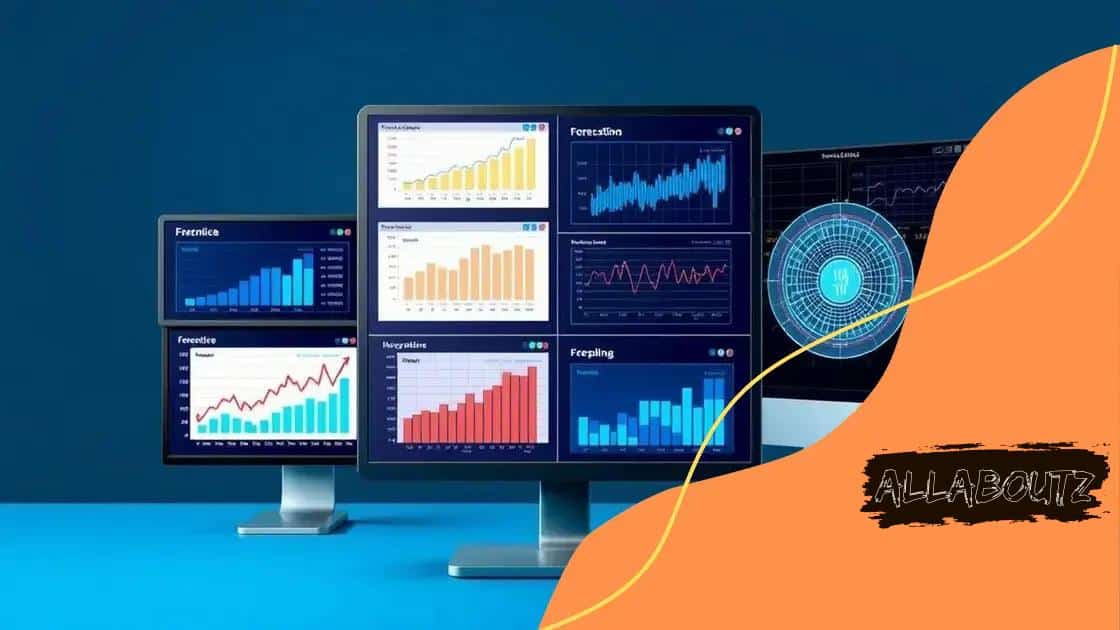AI algorithms used for financial forecasting: uncover the secrets

AI algorithms used for financial forecasting enhance decision-making by analyzing large datasets for accurate predictions, improving efficiency, and enabling data-driven insights across various sectors.
AI algorithms used for financial forecasting are transforming how investors and analysts approach market predictions. Have you ever wondered how these sophisticated technologies might redefine your investment strategies? In this article, we’ll delve into various algorithms and their impact on financial decision-making.
Understanding AI algorithms in finance
Understanding AI algorithms in finance is crucial for anyone looking to navigate the modern financial landscape. These algorithms process vast amounts of data quickly, enabling better decision-making and forecasting. They help investors predict market movements and identify potential risks.
Key Components of AI in Finance
There are several key components that contribute to the effectiveness of AI algorithms in the financial sector:
- Data Analysis: AI algorithms analyze historical data to uncover patterns and trends.
- Predictive Modeling: They create models that predict future market behavior based on past performance.
- Automation: AI automates trading processes, which reduces human error.
- Risk Assessment: Algorithms assess risks by analyzing various market scenarios.
By leveraging machine learning and big data analytics, AI algorithms can improve financial forecasting significantly. For example, they can adjust predictions in real-time based on new data, leading to more accurate assessments. In addition, these technologies help firms personalize their services, catering to client preferences effectively.
How AI Transforms Financial Decisions
The way businesses make financial decisions has changed dramatically with the introduction of AI. It not only enhances efficiency but also reduces costs. Firms can analyze market dynamics faster and identify investment opportunities more accurately.
Moreover, AI allows for better fraud detection. By analyzing user activity, algorithms can spot anomalies, alerting firms to potential threats. This capability is vital in maintaining the integrity of financial systems.
Finally, understanding AI algorithms in finance equips investors and analysts with the tools needed to thrive in a competitive market. By embracing these technologies, firms can gain an edge over their competitors, making informed decisions based on data-driven insights.
How AI predicts market trends
How AI predicts market trends is a fascinating topic in today’s financial world. These algorithms analyze data to forecast future performance accurately. By uncovering patterns, AI helps investors make informed decisions with confidence.
Key Methods of AI Trend Prediction
AI uses various methods to predict market trends, enhancing the ability to interpret complex data:
- Time Series Analysis: This technique examines historical data points to identify trends over time. By understanding past price movements, AI can project future ones.
- Sentiment Analysis: AI analyses social media and news articles to gauge public sentiment, influencing market behavior.
- Machine Learning Models: These models learn from data and improve predictions as they consume more information.
- Neural Networks: They simulate human brain functions to recognize patterns and relationships within large datasets.
By utilizing these methods, AI can predict market shifts before they occur. For example, if a powerful indicator shows a spike in trading volume, AI can prompt traders to act quickly. Understanding how AI identifies these signals is crucial for anyone involved in trading.
The Role of Big Data
The term big data is central to AI predictions in finance. AI algorithms process gargantuan datasets at incredible speeds, allowing for near-instant analysis. This capability enables businesses to adapt to market changes almost in real-time.
Investors can leverage AI-generated insights to make strategic decisions. By recognizing emerging trends early, they can capitalize on opportunities or mitigate losses. The accuracy of predictions improves, leading to better returns on investments.
With AI’s capability to interpret multifaceted data, understanding how AI predicts market trends is essential for modern investors. Those who embrace these advancements will likely gain a significant edge over competitors in the fast-paced financial environment.
Real-world applications of AI in forecasting

Real-world applications of AI in forecasting are transforming industries across the globe. Companies now use sophisticated algorithms to enhance their decision-making processes. From finance to healthcare, AI’s predictive capabilities are proving essential in various sectors.
AI in Financial Services
In finance, banks and investment firms use AI to analyze market conditions and predict future trends. By processing large datasets, these algorithms help investors identify profitable opportunities. They also assist in risk management by forecasting potential downturns. Financial institutions benefit by improving their trading strategies and mitigating losses.
AI in Supply Chain Management
Another example is in supply chain management. Businesses leverage AI to predict demand, optimize inventory levels, and streamline operations. By using historical data, AI can forecast future product needs, allowing companies to reduce waste. This leads to efficient supply chain logistics and cost savings.
- Demand Prediction: AI identifies trends based on previous sales data.
- Inventory Optimization: Algorithms ensure that stock levels meet projected demand.
- Logistics Management: AI helps plan efficient transportation routes.
Retailers also benefit from AI’s forecasting abilities. By analyzing consumer behavior, companies can personalize marketing strategies to suit different audiences. This enhances customer satisfaction and boosts sales. Furthermore, predictive analytics enables businesses to anticipate market shifts, helping them stay competitive.
AI in Healthcare
In healthcare, AI forecasts patient needs and appointments. Hospitals utilize AI to manage schedules efficiently, predicting when resources will be required. This ensures better patient care and optimized staff allocation. Additionally, AI can analyze treatment outcomes, helping healthcare professionals make informed decisions about patient care.
Moreover, companies are using AI algorithms for drug discovery. By predicting how different compounds will react, researchers can develop new medications more efficiently. This innovative approach is speeding up the development of life-saving drugs.
These real-world applications of AI in forecasting illustrate how powerful and transformative this technology can be. As more industries adopt AI, the potential for improved efficiency and decision-making continues to grow.
Benefits and challenges of using AI for financial analysis
The benefits and challenges of using AI for financial analysis are becoming increasingly clear as technology advances. Companies are turning to AI to improve their decision-making processes, gaining a competitive edge in the market. However, understanding both sides of AI implementation is crucial for success.
Benefits of AI in Financial Analysis
AI offers numerous advantages that enhance financial analysis. These include:
- Increased Efficiency: AI processes data much faster than humans, allowing for quicker analyses and real-time insights.
- Improved Accuracy: With advanced algorithms, AI reduces the likelihood of errors in financial forecasts and reports.
- Data-Driven Decisions: AI analyzes large datasets, providing actionable insights that help managers make informed decisions.
- Cost Savings: Automating repetitive tasks cuts down operational costs, enabling firms to redirect resources toward more strategic initiatives.
By utilizing these benefits, businesses can enhance their financial strategies and gain valuable insights into market behavior. For example, companies that adopt AI technologies can gain insights into customer spending patterns, leading to better product offerings.
Challenges of Implementing AI
Despite the advantages, several challenges exist when implementing AI for financial analysis. These hurdles include:
- High Initial Costs: Setting up AI systems requires significant upfront investment, which can be a barrier for some companies.
- Data Privacy Risks: Using AI involves handling sensitive financial information, raising concerns about data security and privacy.
- Skill Gap: There may be a lack of qualified professionals who can manage AI technologies and interpret the data effectively.
- Integration Issues: Existing financial systems might not seamlessly integrate with new AI technologies, causing operational disruptions.
These challenges highlight the importance of careful planning and strategy when integrating AI into financial analysis processes. Companies must weigh the potential benefits against the difficulties they may encounter during implementation.
As the landscape of finance continues to evolve, understanding the benefits and challenges of using AI for financial analysis will position firms for success in a competitive marketplace. Companies that navigate these challenges effectively will reap the rewards of enhanced financial capabilities.
The future of AI in financial forecasting
The future of AI in financial forecasting holds immense potential as technology continues to evolve. Organizations are increasingly recognizing the value of predictive analytics in making informed financial decisions. AI’s capability to analyze trends and patterns will shape the way businesses approach forecasting in the coming years.
Advanced Algorithms
In the near future, we can expect AI algorithms to become more advanced and accurate. Techniques such as deep learning will enable algorithms to process vast amounts of data with higher precision. These advancements will enhance the ability to predict market fluctuations and assess risks. Companies that adopt these sophisticated models will likely outperform their competitors.
Integration with Other Technologies
Another exciting aspect is the integration of AI with other emerging technologies. The combination of AI with blockchain can improve transparency in financial transactions. Additionally, the incorporation of Internet of Things (IoT) devices allows for real-time data collection, further enhancing forecasting capabilities. As data from various sources becomes accessible, AI will use this information to provide more timely and relevant insights.
Financial institutions will also invest more in collaboration tools that integrate AI capabilities with human expertise. This will create a synergy between AI and financial analysts, leading to better decision-making. Humans can interpret AI-generated insights more effectively, which can foster innovation and strategic planning.
Ethical Considerations
As AI continues to shape financial forecasting, ethical considerations will also come into play. Issues surrounding data privacy and bias in AI algorithms need to be addressed. Ensuring transparency in how AI models operate will be crucial for building trust among consumers and stakeholders. Organizations must develop guidelines and regulations to mitigate potential risks associated with AI deployment.
In summary, the future of AI in financial forecasting will likely involve greater accuracy, integration with cutting-edge technologies, and a focus on ethical practices. Companies that embrace these changes will have the opportunity to lead in an increasingly competitive landscape.
FAQ – Frequently Asked Questions about AI in Financial Forecasting
How does AI improve financial forecasting?
AI enhances financial forecasting by analyzing large datasets quickly, uncovering patterns, and providing more accurate predictions.
What are the main benefits of using AI in finance?
The main benefits include increased efficiency, improved accuracy, data-driven insights, and cost savings for financial institutions.
What challenges might companies face when implementing AI?
Challenges include high initial costs, data privacy risks, a skill gap in workforce, and potential integration issues with existing systems.
How can companies ensure ethical use of AI?
Companies can ensure ethical use by developing guidelines for transparency, addressing biases in algorithms, and prioritizing data security.





